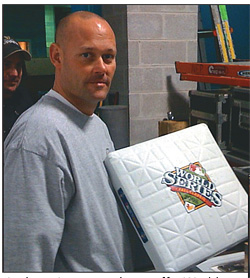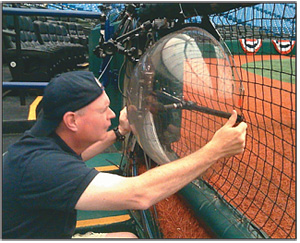Just Like Being There
LOS ANGELES
Auto racing circuits, basketball arenas, and baseball and football stadiums each present different and specific challenges to sports audio mixers when designing microphone coverage to match the visual presentation.
Cameras placed in the stands and also at trackside enhance Fox’s NASCAR coverage, but can make audio requirements more demanding.

Anthony Lomastro shows off a World Series base outfitted with a Sennheiser MKE 2. “I can take you from a viewer’s perspective, which is normally the wide coverage, and I can take you right next to the track and let the car come right through the room,” said Fox Sports audio consultant, Fred Aldous, who also mixes NFL games.
Aldous settled on an array of Audio-Technica, DPA and Sennheiser models for the races, after careful evaluation of 18 different mics in 2001, when Fox was awarded the broadcast rights.
“For everything trackside I use a DPA 4007,” Aldous said. “That was the only thing that would really handle the SPL. It’s a great microphone with a full frequency response. It’s weatherproof, so I don’t have to worry about the moisture from the morning dew or morning fog, and I don’t have to worry about the debris from the track getting in there because it’s got a sealed capsule. It really is the right microphone for the application.”
INTO THE LIVING ROOM
Audio-Technica 825ST cardioid stereo mics are positioned at the catch fence to further enhance the pickup.
“With some delays and some magic dust I create a nice surround mix,” Aldous said. “I can make the car sound like it’s flying through the room for the most part.”
A-T 815ST mics on the cameras up in the stands are used to provide a wide stereo image.
“It’s not necessarily a left-right perspective, because we’re up higher,” Aldous said. “We’re panning with the car, so I need something to fill that left-right soundfield. I also use some Sennheiser MKH 70s if I want a nice tight AB pattern where left-right perspective is necessary on an up camera.”
BASEBALL’S REQUIREMENTS
Joe Carpenter, a production mixer who has worked on National League and World Series games for Fox, builds his 5.1 surround field from a variety of elements.

Fred Ferris aims a parabolic Sennheiser MKH 8000 series mic. “It all starts with the parabolic microphones that are focused around home plate,” Carpenter said. “I really like the Sennheiser MKH 8000 series for this application, with the omni capsules.”
Carpenter says that one of the mics is positioned on the first base line and another is on the third base line.
“I try to put them in a place where they’re focused on the plate and the pop of the glove is not blocked by the umpire or the catcher,” he said. “The one behind home plate is as high as I can get it pointing as far down as I can get it.”
As part of the audio package, Carpenter builds a simple surround environment that includes a pair of Sennheiser MKH 416 shotguns in an XY configuration in center field.
“They’re as far away from the fans as possible, and they’re behind you,” he said. “That’s the basis for the surround environment. Then I add a pair of microphones that are as far apart as I can get them in an AB pattern, at high first and high third base. I want those mics pointing across the stadium to the farthest crowd.”
Carpenter also places some mics around the playing field’s perimeter.
“In baseball the only place where I can put mics in the field of play is in the bases,” he said. “Because of their size and their omni pattern we use Sennheiser MKE 2s. We custom drill our own holes so that we’re completely isolating the mic from the base. We aim them toward the outfield side because someone sliding will dust the mic over with dirt and mud, making it useless for the rest of the inning.”
A submixer in the booth is in charge of those perimeter mics.
“He’ll fill a 32-channel Midas Venice console, and will have three or four parabolic mic operators in the outfield, and a bunch of Crown PCC pressure zone and [Sennheiser] MKE 2 lavs,” Carpenter said. “He puts those any place that makes noise—for instance, on the foul poles. If they get hit you’re going to hear it.”

Joe Carpenter builds his surround field from a variety of elements.BALANCING ACT
Rather than building a surround field from multiple mics, Jonathan Freed, a 35-year veteran who mixes football and basketball on network television, adopted the Holophone H-2 single point source surround mic last year.
“It’s easy: it’s one microphone, it has one mounting point, and it’s got all its connectors available. It’s a good time saver,” he said.
Depending on the sport being covered, Freed has his own favorite location for the Holophone H-2.
“For football games the spot I like the best so far is putting it at the boundary between the crowd and the field of play,” he said. “The Holophone has a unique ability to bring that intimacy to the crowd mix and still keep a nice surround bed, and it’s neither overwhelmed by the nearest crowd nor does it fail to pick up the size of the arena. It’s a great single point solution, but because a football arena is so large, it needs to be augmented by other mics to get the final impression of size.”
Bringing back surround audio from basketball games is another story, as the action is taking place in an enclosed arena.
“I generally place [the H-2] up high near our camera basket,” Freed said. “It always lends a nice sense of focus to the surround bed.”
Freed typically uses a combination of Sennheiser and Neumann microphones to augment the H-2.
The particular sports venue may require some fine tuning of miking technique too, especially in football coverage.
“There’s always a pair of mics up very high, then a variety of arrays that I’ll set up, down either near the Holophone or at other points on the field, depending on the arena,” Freed said. “I usually put Neumann KM 84 or 185 cardioids up high as a stereo pair. Depending on the arena they will either be XY or AB. Down low I like to use Sennheiser MKH 416 short shotguns. Because it’s a short shotgun it has a lobe, so I’m able to aim it. With those mics I’m trying to get a sense of space without too much nearfield pickup of crowd.”
But, he cautioned, “You have to always be careful as you deploy other microphones that you don’t get a blur. You tend to think it sounds better and better as you add more and more. But sometimes less is absolutely more.”
The professional video industry's #1 source for news, trends and product and tech information. Sign up below.
